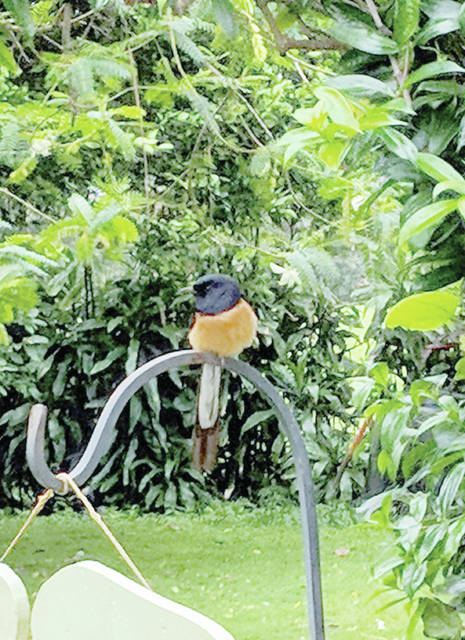Here we are one week into May, sunning up slightly with clouds girdling the high center of our island like a soft, white cape resting on purple shoulders. Summer hopefully is on the way. Sun = drying out, warming up. That simple formula’s bound to uplift the spirits, especially those who suffered losses, were sodden and had water ruination in the March and April floods, and including our hardworking road and park maintenance, and Kauai Island Utility Cooperative workers.
April 30th marked the end of our home garden ulu (breadfruit) crop. One or two really late “fruits” landed in soggy plops after over-ripening. We let them lie for the benefit of our wild chickens, who’ve been subject to less bounty with no starfruit, noni, lemons or tangerine falls available recently (they barely tolerate kaffir limes). Those free-rangers cleaned out the ulu, leaving only traces of rind. In between scavenging for an occasional stale bagel or handful of rice, our Rooster Guy (RG), his lesser brah (brother), and his ladies have resorted to attacking ripening bananas — from high in the ulu tree, no less. RG himself has been seen demonstrating that he can easily jump almost 3 feet straight up in order to gobble red ti berries, a move I’ll christen “stalking the stalk.”
My husband Dee (nicknamed Dee-Bird) and I do like our wild — and free — birds. Penned up inside during one recent heavy rainstorm, he started modeling what he hoped would turn out to be a shama thrush of terra cotta clay that would whistle like some bird-shaped ocarinas we purchased during travels in Peru, or a whistling bluebird found at a folk festival in Gottland.
Dee engineered it lean and hollow, and added a flute hole. But nary a musical sound could he get from it, even after studying a demonstration on making clay ocarinas on YouTube. One nice thing about wet clay, you can rectify anything you consider a mistake. The sound hole is now closed and smoothed over. The bird model, now my shama, awaits painting.
My hope is that Dee tries his hand at more bird shapes — possibly some of the rarer ones, the endangered birds we admire that eke out existence in the forests of Kokee, e.g. the puaiohi (Kauai thrush), the iiwi (scarlet Hawaiian honeycreeper), the akikiki (endemic creeper), among a few. I also hope that my husband won’t give up on the desired musical aspect of his bird models. However, with summer and drier days coming, there’ll be lawn to mow, weeds to whack/pull, bushes to clip, plus let’s not forget golf (!) on those lush greens.
On the golf courses, there are birds to watch, as well: On fringing areas of seaside courses, occasional ruddy turnstones, and sailing overhead, iwa (great frigatebirds); on the fairways, barred doves and mynahs, and “cheekens.” These last reflect DNA of the original Asian jungle fowl mixed with that of escaped or storm-blown domestic fowl, any brand of favorite laying hens.
There are kolea (golden plovers), in season. And watch out for nesting nene geese in and around the water hazards, because these Hawaii offshoots of Canada geese can attack ferociously if you get a bit too close to their offspring. We’ve seen numerous alae (Hawaiian gallinules and mudhens). Once, after a past big rain, some red-legged stilts arrived to wade among waterlilies while clamming beside the 4th fairway.
Seen around the 10th hole of the Wailua Golf Course in the last few years are Muscovy duck, and aukuu (black-crowned night herons)
— smart ones, that have learned how to fish, tossing bits of bread or snacks they’ve scavenged into the pond and pouncing when fish rise to the occasion.
Rains haven’t diminished our bird populations, just as they don’t seem to have impacted our tourist population. A fair number of island visitors enjoy seeing our birds, even beyond the cocky, showy one they always ask about — the introduced red-headed, or Brazilian cardinals. We have dyed-in-the-wool (feathers?) capital “B” and “W” Bird Watchers coming, too. Some time back I learned of the existence of a birdwatching society, Birdingpal.org, which maintains a well-recognized website centered in Scandinavia that puts one in touch with birding tours. Knud Rasmussen (dubbed “The Real Most Interesting Man”) founded Birdingpal to be a club with a big difference: Its area would be the whole world.
After joining, numerous inquiries from my fellow Birdingpals have arrived through a protected link. It’s amazing how many travelers aim for Hawaii — and Kauai, especially Kokee — because of our endangered species. They come armed with their bird lists and hope to glimpse (and check off) a number of never-previously-seen avian specimens. Their tropical vacation centers on this desire. We figure this is a whole lot healthier than shooting or trapping trophy, and more culturally correct than focusing on mai tais and dancers wearing (the highly questionable) coconut bras!
This March, the Kauai Forest Bird Recovery organization — and their thrust to save, among other birds, our akikiki — received national play in The New York Times. You can read all about it and see fine photos at https://www.nytimes.com/2018/
03/13/magazine/should-some-species-be-allowed-to-die-out.html
•••
Dawn Fraser Kawahara, author and poet, made her home on Kauai in the 1980s. She and her husband, a retired biology teacher, live with books, music and birds in Wailua Homesteads. Shared passions are travel and nature. The writer’s books may be found in local outlets and on Amazon. For further information, tropicbirdpress@gmail.com.


